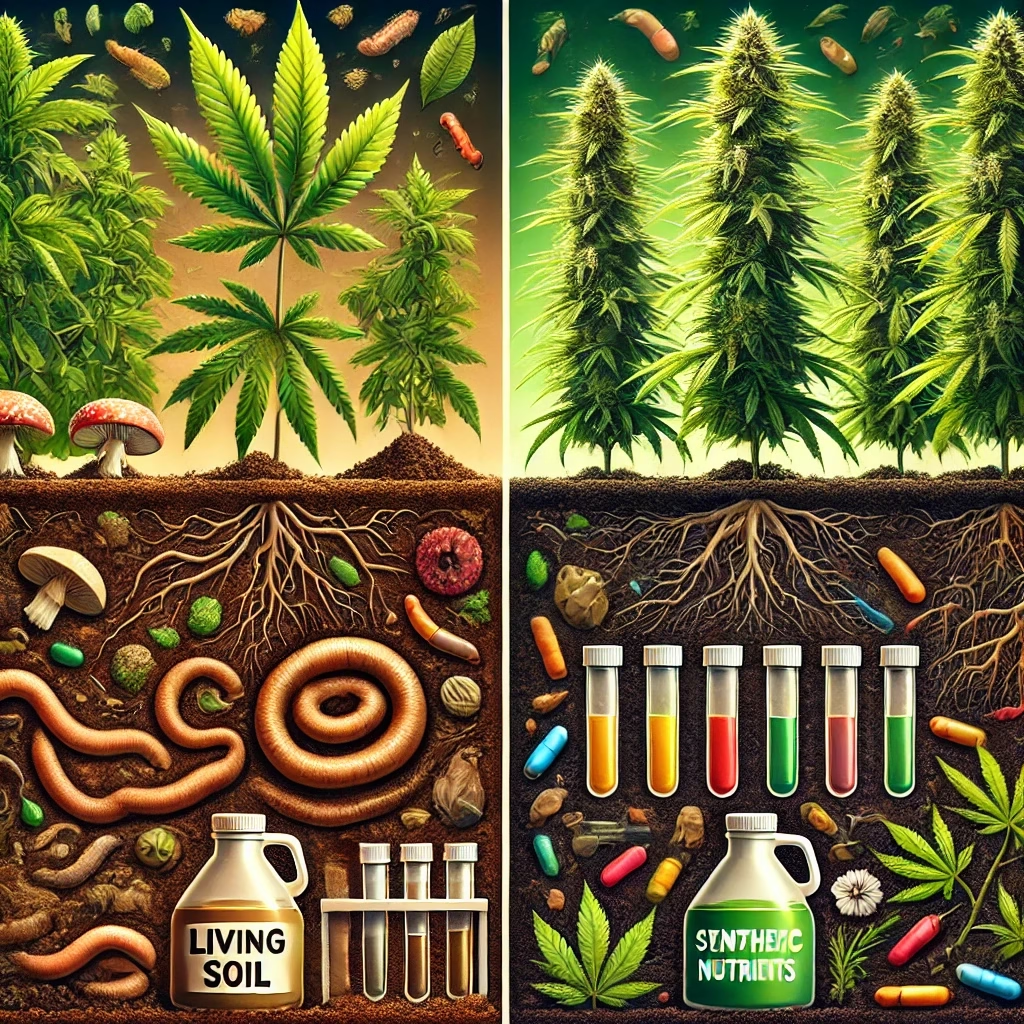Living Soil vs. Synthetic Nutrients: Which is Better for Cannabis Cultivation?
Growing cannabis requires careful consideration of the nutrients that fuel plant growth. Two primary approaches dominate the cultivation world: living soil and synthetic nutrients. Each method has its unique benefits and drawbacks, and understanding the differences can help growers make informed decisions. Whether you’re an organic enthusiast or a high-yield seeker, knowing how these two methods impact plant health, potency, and sustainability is key. Let’s explore both approaches to see which one suits your cultivation goals best.
What is Living Soil?
Living soil is an organic growing medium rich in beneficial microbes, fungi, and organic matter. It creates a self-sustaining ecosystem where microorganisms break down organic compounds into nutrients that plants can readily absorb. This approach mimics natural soil environments, promoting biodiversity and long-term soil health. Growers using living soil often rely on compost, worm castings, and natural amendments like bat guano and kelp meal to maintain soil fertility. The result is a thriving, nutrient-rich substrate that continuously feeds cannabis plants.
Benefits of Living Soil
- Organic and Sustainable: Living soil reduces reliance on chemical fertilizers, making it eco-friendly.
- Enhanced Terpene Profiles: Many growers report richer aromas and flavors due to the diverse nutrient availability.
- Natural Nutrient Cycling: Beneficial microbes break down organic matter, providing a steady nutrient supply.
- Less Risk of Nutrient Burn: Unlike synthetic nutrients, living soil releases nutrients gradually.
- Improved Soil Health: It promotes biodiversity and can be reused for multiple grow cycles.
Challenges of Living Soil
- Slower Growth Rates: Organic nutrient breakdown takes time, leading to potentially slower plant development.
- More Space Required: Large soil beds or containers are needed to maintain microbial diversity.
- Higher Initial Setup Costs: Creating a rich, living soil mix requires investment in high-quality organic amendments.
- Difficult to Adjust Nutrients Quickly: Once deficiencies appear, correcting them takes longer compared to synthetic nutrients.
What Are Synthetic Nutrients?
Synthetic nutrients are lab-created fertilizers that provide plants with immediate access to essential minerals. These nutrients come in liquid or powder form and are formulated for precise control over plant growth. Many commercial cannabis cultivators prefer synthetic nutrients because they deliver fast results and can be easily adjusted to optimize yields. Hydroponic systems, where soil is replaced with nutrient solutions, often rely entirely on synthetic feeding schedules.
Benefits of Synthetic Nutrients
- Faster Plant Growth: Nutrients are readily available for quick absorption, speeding up vegetative and flowering cycles.
- Precise Nutrient Control: Growers can adjust nutrient levels based on the plant’s stage and needs.
- Higher Yields: Many commercial cultivators achieve maximum yields with synthetic feeding.
- Easier Deficiency Correction: If a plant shows signs of nutrient stress, solutions can be adjusted immediately.
- Works Well in Hydroponic Systems: Soil-free growing setups depend on synthetic nutrients for plant survival.
Challenges of Synthetic Nutrients
- Risk of Nutrient Burn: Overfeeding can damage plants due to excess salts and chemical buildup.
- Lack of Microbial Activity: Unlike living soil, synthetic feeding doesn’t support beneficial soil organisms.
- Requires Flushing: Accumulated salts need to be flushed out before harvest to prevent harsh flavors.
- Environmental Concerns: Synthetic fertilizers can contribute to nutrient runoff, impacting ecosystems.
- Cost Over Time: Continual purchase of bottled nutrients can add up in expenses compared to reusable organic soil.
Which is Better for Cannabis Cultivation?
The choice between living soil and synthetic nutrients depends on your cultivation priorities. If you value organic methods, sustainability, and enhanced flavors, living soil might be the best fit. However, if you prioritize rapid growth, large yields, and precise feeding control, synthetic nutrients could be more suitable. Some growers even combine both approaches, using organic soil while supplementing with mild nutrient solutions when needed.
Ultimately, there’s no single right answer—just the best method for your specific growing environment and goals. Whether you embrace the natural balance of living soil or the high-performance precision of synthetic nutrients, understanding their differences will help you cultivate healthier, more potent cannabis plants.


